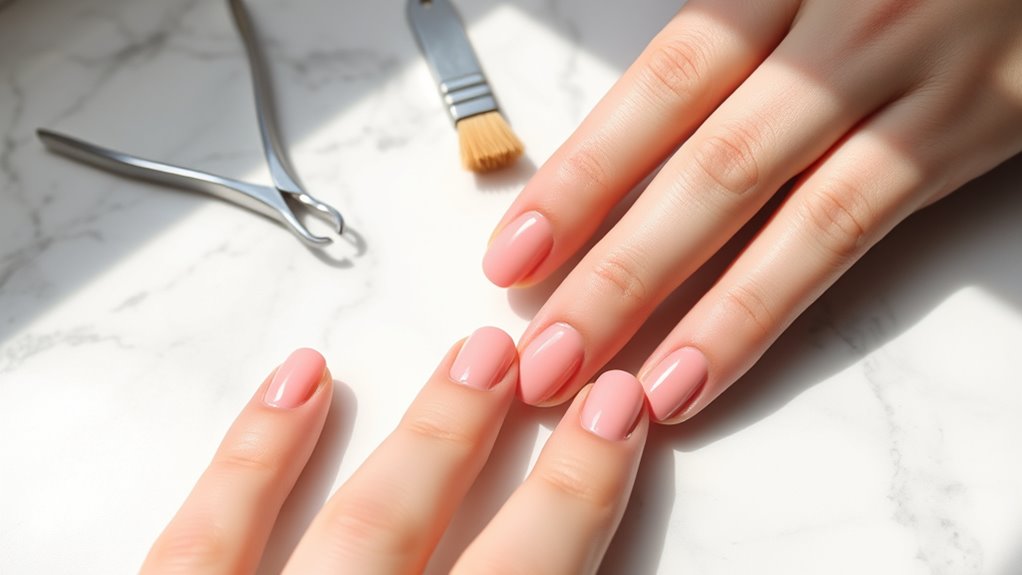To keep your nails healthy and beautiful, focus on good hygiene by regularly cleaning, trimming, and avoiding nail biting. Moisturize with cuticle oil or lotion, and eat a balanced diet rich in biotin, zinc, and vitamins A, C, and E to promote strength and growth. Use gentle polish removal and apply base and top coats for lasting color. For more tips on maintaining gorgeous nails, continue exploring the essential techniques and habits.
Key Takeaways
- Maintain proper hygiene by regularly cleaning, trimming, and avoiding nail biting or picking.
- Moisturize nails and cuticles with oils or lotions to promote strength and flexibility.
- Eat a balanced diet rich in biotin, zinc, and vitamins A, C, and E for optimal nail growth.
- Use gentle nail polishes, apply base and top coats, and remove polish carefully to prevent damage.
- Seek professional advice if nails show persistent discoloration, brittleness, or signs of infection.
Understanding Nail Anatomy and Common Problems
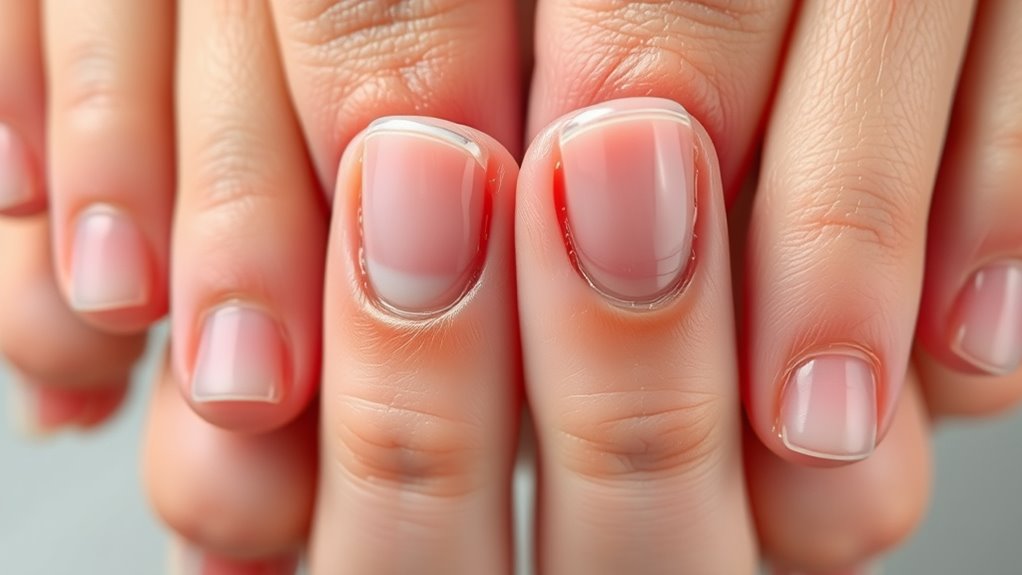
Understanding nail anatomy is essential for maintaining healthy nails, as knowing how your nails are structured helps you identify common problems early on. Your nails consist of several parts: the nail plate, which is the visible, hard surface; the nail bed beneath it; the cuticle that protects the base; and the lunula, the white crescent at the base. Damage or infections can occur at any of these sites, leading to issues like ridges, discoloration, or brittleness. Recognizing signs of problems early allows you to take appropriate action, whether that’s adjusting your care routine or seeking professional help. Being familiar with your nail anatomy empowers you to distinguish between minor concerns and more serious conditions, helping maintain the health and appearance of your nails.
The Importance of Proper Nail Hygiene
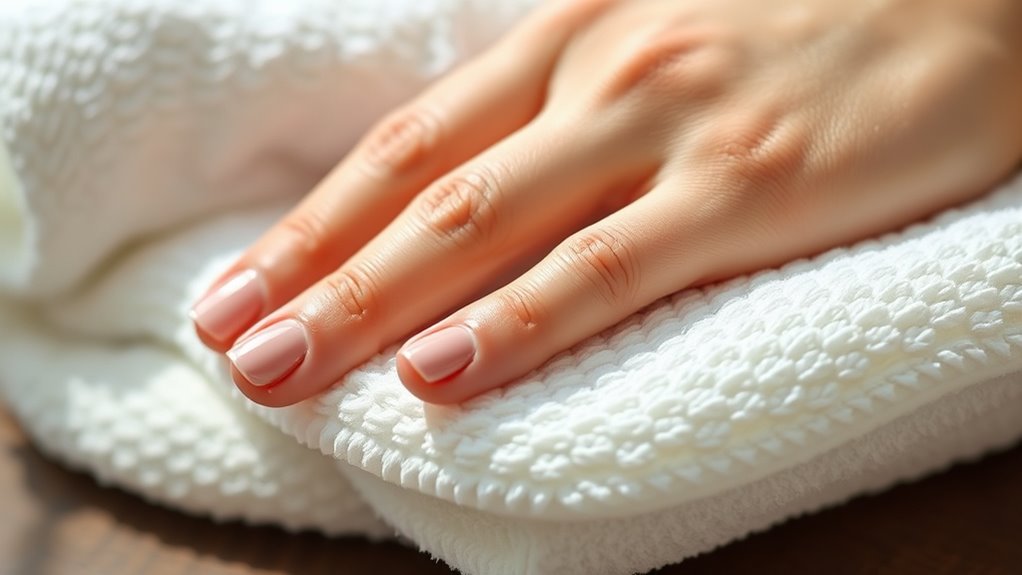
Maintaining proper nail hygiene is essential for preventing infections and keeping your nails healthy. When you care for your nails correctly, you reduce the risk of fungal or bacterial growth that can cause pain and discoloration. Regularly cleaning your nails helps remove dirt, debris, and germs that can accumulate in the small crevices around your cuticles. Proper hygiene also involves trimming nails neatly and avoiding biting or picking at them. Incorporating proper nail care practices can further support nail health and prevent common issues.
Proper nail hygiene prevents infections, keeps nails healthy, and reduces dirt and bacteria buildup.
These habits support strong, attractive nails and overall nail health.
Essential Tips for Nail Strength and Growth

Taking good care of your nails goes beyond hygiene; focusing on their strength and growth can make a noticeable difference. To promote healthy nails, keep them moisturized with cuticle oil or hand lotion, which prevents dryness and splitting. Incorporate a biotin supplement or eat foods rich in vitamins B7, E, and zinc to support growth from within. Avoid harsh chemicals by wearing gloves during cleaning or using acetone-free polish removers. Keep your nails trimmed and filed regularly to prevent breakage and snagging. Additionally, give your nails breaks from polish to allow them to breathe and recover. Staying hydrated and maintaining a balanced diet are essential for nourishing your nails from the inside out, ensuring they stay strong, flexible, and grow steadily. Regular use of HEPA filtration air purifiers can also help keep the air clean, reducing exposure to pollutants that may weaken nails. Implementing proper air quality measures can positively impact your overall health, including nail strength. Furthermore, recent AI discoveries suggest that advanced technology might soon offer innovative solutions for nail health monitoring and enhancement. In addition, integrating Natural Language Processing (NLP) technologies into health apps could personalize nail care routines based on individual needs.
Best Practices for Nail Polishing and Removal
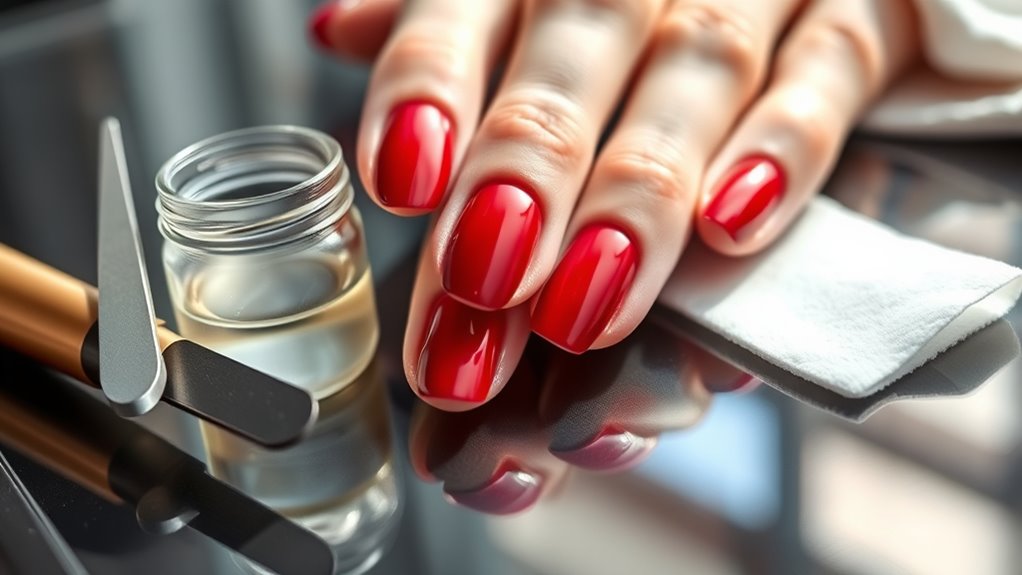
Proper nail polishing and removal are essential to keep your nails healthy and looking their best. When applying polish, start with a clean, dry surface, and use a base coat to protect your nails. Apply thin layers of color, allowing each to dry completely before adding the next. Finish with a top coat for shine and durability. For removal, avoid harsh scrubbing or ripping off polish, which can damage your nails. Instead, soak a cotton ball in acetone-based remover and gently press it on your nail for a few seconds before wiping away. Here are some tips to keep in mind:
- Always use quality remover and avoid excessive rubbing.
- Limit polish removal to once a week to prevent dryness.
- Moisturize your nails and cuticles afterward to restore moisture.
- Ensuring proper removal techniques can also prevent damage caused by improper application.
- Choosing gentle nail care practices can also help preserve the strength and health of your nails.
- Being aware of nail health maintenance can further improve your nail appearance and durability.
- Incorporating hydration and nutrition into your routine can promote stronger, healthier nails.
Nourishing Your Nails With the Right Diet and Supplements

Healthy nails start from within, and your diet plays a key role in their strength and appearance. To promote healthy nails, include foods rich in biotin, zinc, and vitamins A, C, and E. Supplements can also help if you’re deficient, but consult a healthcare professional first. Incorporate these nutrients regularly to strengthen nail beds and encourage growth.
| Nutrient | Food Sources |
|---|---|
| Biotin | Eggs, nuts, sweet potatoes |
| Zinc | Shellfish, beans, seeds |
| Vitamin A | Carrots, spinach, sweet potatoes |
| Vitamin C | Citrus fruits, bell peppers |
When to Seek Professional Help for Nail Issues
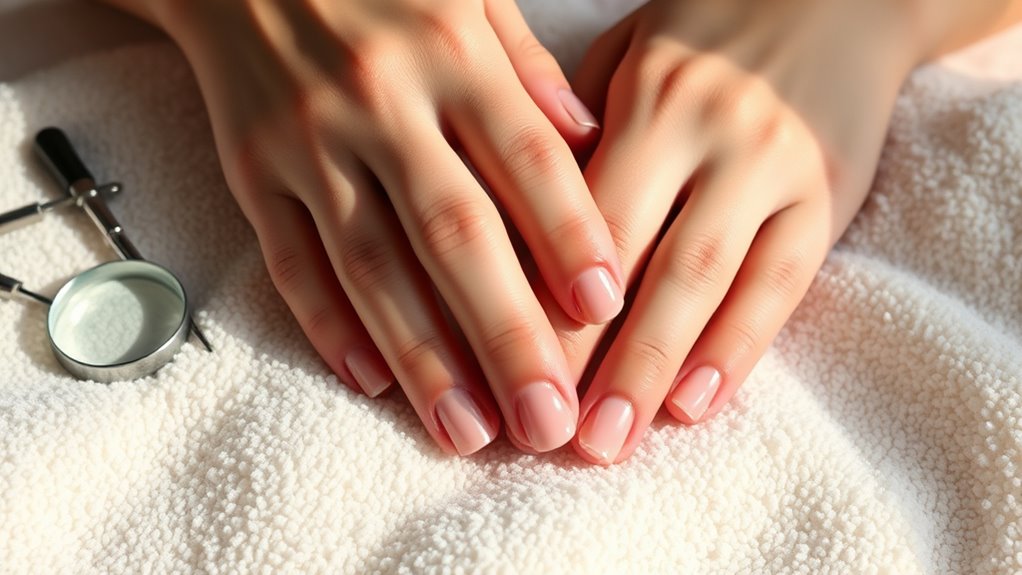
While minor nail issues like ridges or slight discoloration can often be managed at home, you should see a professional if you notice persistent changes, pain, or signs of infection. If your nails become thick, brittle, or develop unusual spots, it’s time to seek help. Also, watch for symptoms like redness, swelling, or pus around your nails, which indicate infection. Don’t ignore significant changes in nail color or shape, as these could signal underlying health problems. A dermatologist or nail specialist can diagnose and treat issues properly, preventing complications. Be aware that nail changes can sometimes be linked to health conditions, so timely consultation is important. For example, nail health can reflect your overall wellness and should be evaluated if abnormalities persist. Additionally, changes in nails may be associated with systemic diseases, highlighting the importance of professional assessment. Recognizing early signs of serious conditions can make a crucial difference in treatment outcomes. Moreover, regularly monitoring your nail health can help in early detection of underlying issues, especially with the increasing impact of cybersecurity vulnerabilities on personal health data.
Frequently Asked Questions
How Often Should I Trim My Nails for Optimal Health?
You should trim your nails every one to two weeks to keep them healthy and strong. Regular trimming prevents hangnails and reduces the risk of infections. If you notice your nails growing quickly, you might need to trim more often. Use clean, sharp scissors or clippers, and avoid cutting too close to the skin. Consistent trimming, combined with proper nail care, helps maintain beautiful, healthy nails.
What Are Natural Remedies for Nail Fungus?
Imagine your nails as tiny gardens needing care. For nail fungus, you can try natural remedies like tea tree oil, which acts as a powerful gardener fighting off pests. Soak your nails in a mixture of vinegar and water to create an acidic environment that inhibits fungus growth. Keep your nails dry and maintain good hygiene. These gentle yet effective steps help restore your nails’ health naturally.
Can Nail Polish Cause Long-Term Damage?
Nail polish can cause long-term damage if you don’t take proper care. Constant use without breaks may weaken your nails, leading to brittleness and thinning. Some polishes contain harsh chemicals like formaldehyde or toluene, which can cause discoloration or allergic reactions over time. To protect your nails, give them regular breaks, use nourishing base coats, and choose non-toxic polishes. Proper care helps maintain healthy, strong nails in the long run.
Are There Specific Vitamins That Promote Nail Growth?
Did you know that biotin deficiency can lead to brittle nails? To promote nail growth, you should consider vitamins like biotin, which supports keratin production, and vitamins A, C, and E for overall health. Zinc and iron also play essential roles. By including these in your diet or supplements, you can strengthen your nails and encourage healthy growth, making them look vibrant and resilient.
How Can I Prevent White Spots on My Nails?
White spots on your nails are often harmless and can result from minor injuries or zinc deficiencies. To prevent them, avoid nail trauma, wear gloves during chores, and maintain a balanced diet rich in zinc, calcium, and vitamins. Keep your nails moisturized and avoid harsh chemicals. If spots persist or worsen, consult a dermatologist to rule out underlying health issues. Staying gentle with your nails helps keep them healthy and clear.
Conclusion
By following these nail care tips, you’re planting seeds for healthy, beautiful nails that flourish with care. Remember, your nails are like a mirror reflecting your overall health—nurture them, and they’ll shine brightly. Stay consistent and attentive, and you’ll turn your nails into a stunning canvas of self-care. With patience and proper habits, your nails will thrive, proving that beauty truly starts from the inside out—like a garden blooming with love and attention.
